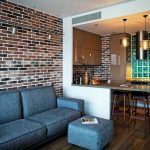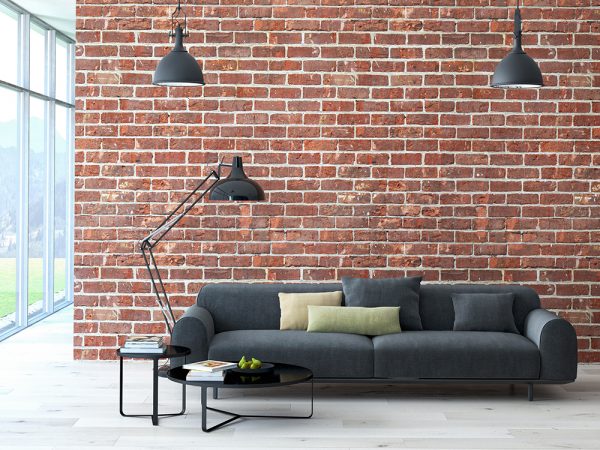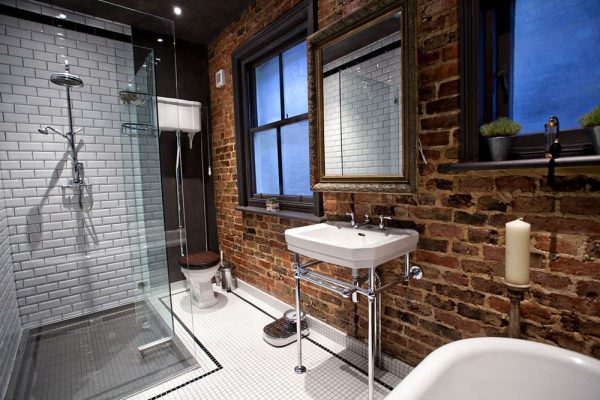Initially, brick was used only in construction. Gradually, this versatile and environmentally friendly material began to be used in interior decoration, despite its apparent rudeness and coldness. Now the brick in the interior is a fashionable, stylish detail, and both ordinary material and its imitation are used.
- Where can I use a brick
- Pros and cons of finishing material
- Varieties of brick finishes
- Finishing methods and styles
- Loft
- Country and Provence
- Gothic
- Minimalism and hi-tech
- Grunge
- English classic
- Scandinavian style
- Color schemes
- White
- Gray
- Red
- Brown
- Brick in different rooms
- Kitchen and dining room
- Living room
- Bedroom
- Corridor and hallway
- Bathroom
- Material Care Rules

Where can I use a brick
Typically, a brick in an apartment or house is associated with a loft style. Indeed, the "industrial" style directions were the first to adopt it, but then the material began to be introduced into other types of design - country, hi-tech, minimalism and even classics. It is suitable for all rooms in the house, including - for loggias, balconies.

Using masonry, you can decorate walls, partitions, individual sections of the room. It performs a decorative and practical function - it participates in the zoning of a room. If desired, you can attach any decor and lighting devices, equipment to the brick.
to contents ↑Pros and cons of finishing material
Brick is an environmentally friendly material, because it is made on the basis of natural components (clay, quartz sand, lime). The porous structure of the elements provides an optimal microclimate in the room, prevents rotting, moldy surfaces. Brick is considered a very durable raw material - it serves for decades, and with additional surface treatment, its service life is almost unlimited.

Other advantages of brick in the interior:
- Beauty. Brickwork looks stylish, unusual. She herself serves as a bright accent in the room, even without additional decoration. If you have such a finish, you can save on furniture by buying the simplest.
- Range. The material is available in different shades, which depends on the type of firing, additional components in the composition. Imitation of brick and may even have the most bizarre colors. In addition, any brick can be painted with suitable coatings.
- Heat resistance. Brick is used for finishing any surfaces, even heating ones. That is why it is ideal for a kitchen apron by the stove, for the fireplace area. The material is not afraid of temperature extremes, as well as freezing. It is suitable for outdoor work and cladding of rooms that are not heated in winter.
- Availability and simplicity. Compared to other types of finishing, brick is inexpensive. To prepare the walls you will not need expensive materials, because the masonry will hide the existing defects. Strict leveling of the surface by level is also not necessary. Facing work can be done even by a novice.
- The possibility of restoration. Especially good are materials that imitate brick.In case of damage, they can be repaired using special building mixtures and painted.
- Soundproofing. A brick wall misses a few extraneous sounds, dampens noise.

Despite the mass of advantages, this material also has drawbacks. It looks more beautiful in spacious rooms. It is here that the brick provides a feeling of comfort, home warmth. In small apartments, when using it, there is a risk of visually hiding the space.
The brick boasts good moisture resistance. Nevertheless, when facing zones that are regularly exposed to direct contact with water, it will be necessary to additionally apply hydroprotective compounds to the masonry. An uneven surface with embossed texture is more difficult to maintain than smooth substrates. Often dust accumulates in the cracks of the masonry, and wiping it is quite inconvenient.
Some users complain that the material in the decoration carries a feeling of incompleteness. The walls look rude, cold. The situation can be corrected by the correct arrangement of accents and the use of additional decor. Untreated bricks usually need good lighting. An alternative solution is to dye the material in bright or white.
to contents ↑
Varieties of brick finishes
The premises use different types of masonry, some of which are not directly related to the main material. Here are the varieties of finishes:
- Real masonry. A wall made of ordinary brick is not plastered, not covered with GKL sheets. Only minimal surface treatment is performed. They wash it, grind it, wipe the joints with a special grout. If desired, the masonry is varnished or painted in the desired color. This decoration is more suitable for spacious rooms with high ceilings.
- Wallpaper with a print "brick". The easiest way to decorate a wall with a brick is to stick the appropriate wallpaper. They can be placed on the entire wall or glued only part - a certain area, niche, fragment. At the same time in the room you can use the lining with decorative plaster, wood, tiles. A variety of "brick wallpaper" are textured canvas for painting. They are white, therefore they must be painted in any shades.
- Facing brick. Such material is thin, light, it can be used for finishing the most weak walls, partitions and lightweight structures. Such an artificial stone is glossy, matte, artificially aged, with craquelure effect, glazed.
- Tile "brick". Clinker or ceramic material with a color that imitates natural brickwork is often used in the bathroom and in the kitchen. This tile is very practical, durable, but requires high-quality alignment of the walls before gluing.

Finishing methods and styles
Brickwork or its imitation can be done in different ways. It can occupy an entire wall or serve as a small but catchy detail. Here are the main ways to introduce material into the interior:
- Fragment. In this case, the masonry extends to part of the wall. The reception is popular in the Scandinavian style. Examples are the partition, the area behind the bed from floor to wall.
- Accent. Allocate a site on which it is supposed to pay increased attention. Examples are the area by the fireplace, behind the TV, at the head of the bed.
- Wall. Brickwork, which is used to decorate the entire wall, looks very attractive. Usually highlight the wall that carries the greatest semantic load. Examples are the large wall behind the sofa, the dining area.
- Element. With the help of bricks, they finish only some architectural form - an arch, a bar counter, a curbstone under an aquarium.

to contents ↑The brick is suitable for many interior styles. Now it is used even in classics, although industrial areas remain the most popular in the arrangement of masonry.
Loft
This style implies the use of rough materials - metal, plaster, stone, concrete, brick. It resembles the decoration of workshops, factories, industrial enterprises, but it adapts to the daily needs of a person. It is important that the room has a large size and high ceilings, otherwise the brickwork will hide the extra space.
Loft involves bricking an entire wall or several walls. An equally fashionable technique is the design of partitions that divide the room into two zones. You can use different shades of brick, as well as material "antique" or with the brand of the manufacturer.

Country and Provence
The rustic style is no less popular than the loft. It provides for the use of natural materials - wood, cork, stone, as well as ceramics, glass and textiles, which look amazing on a brick background. Country is ideal for large country houses. Style is associated with comfort, tranquility and relaxed relaxation.
In Provence, small brick inserts or fragments of walls are used almost always. If the material is white, beige, milky or ocher, then the entire wall is finished. She will play a background role in the room. On the wall you can arrange decor - shelves, flowers, panels, coasters for dishes and figures.

Gothic
In the Gothic style, a brick of dark colors can be used in large volumes, for example, for finishing adjacent or opposite walls. The material here should be combined with other style attributes - forged products, ceiling beams, wood, stucco, frescoes.

Minimalism and hi-tech
Both styles can use brick, but more often in the form of imitation. Usually the material of white, gray, dark brown color reveals the whole wall or part of it. It is important that the masonry is well combined with the finishing materials of the ceiling and floor.

Grunge
The basic concepts of this design direction are simplicity and solidity. Grunge involves large spaces and a lot of light, because small rooms will not suit him. Wall decoration should be light using natural materials. Brick, stone and wood are ideal for grunge. Often applied the effect of aging textures, finishing with raw, rough materials. Design necessarily includes elements from textiles - cotton, wool, linen.

English classic
Despite the strictness of design, elements from brick may also be present in the classic. In this case, the interior should be given a resemblance to a medieval castle, where masonry was often used. Typically, the material is used in the decoration of the living room and hall.

Scandinavian style
Interior design in this case involves an abundance of light colors, free space, air and freshness. A brick wall can be large in size, but always light - milky, white, beige. Such bricks can be used to tint a fireplace zone or a section behind a TV.

Color schemes
Brick is sold in several shades. The material can be painted after installation. This will reduce excessive porosity, facilitate cleaning, and help beautifully fit the masonry into the interior.
White
The material of snow-white color will increase the space, which is especially important in small rooms. Such a brick wall will serve as a backdrop for interesting decorative elements, appliances, furniture. In the Scandinavian style, white brick is used in its pure form, in country - in combination with red.

Gray
Like white, gray is considered neutral, unobtrusive. It will become the background color for decor and furniture. A light gray tone expands the space, dimming the brightness of another finish. The dark color gives comfort, intimacy, soothes, but is suitable only for large rooms.

Red
Such a brick is made of red clay, although it can be painted in the corresponding color. Most often, red brick is used in Gothic, classic, country, loft. The masonry of a bright shade can not be additionally decorated - it will itself be a juicy stain in the room. It must be remembered that the furniture is lost against the background of such walls, so it is better to install the simplest products.

Brown
Designers advise more often to use brown brick in interior design, because it looks stylish and beautiful. For coloring, you can use wood stain of the desired shade. It is recommended that some bricks be left unpainted to create an interesting contrast effect.

Brick in different rooms
Wanting to bring a little rough naturalness into the interior, designers introduce brickwork into different rooms, but with their own characteristics. It is important that it looks neat, and the project has been carefully thought out in advance.
Kitchen and dining room
Typically, an apron is placed in the kitchen next to a work surface with a brick. For this purpose, decorative brick with a relatively smooth surface is more suitable. Too embossed details will be difficult to wash. So that they do not deteriorate from fat, it is recommended to use special protective compounds. You can generally cover the masonry with plexiglass or transparent plastic.
It is advisable to choose small elements of the color that is well suited to the rest of the finish. An apron of a contrasting shade looks interesting, for example, red against a background of white walls. Brick in the kitchen goes well with wood, metal, and ceramics.

Other brick kitchen options:
- two or three brick walls (ideal for a loft);
- brick ceiling;
- a small decorative panel in the dining area;
- a fragment of the wall to emphasize fashion equipment, furniture;
- wall between the kitchen and the dining room or living room for zoning.
Living room
In the living room, a simple method of decorating is often used - finishing one wall with brickwork. Lined columns look elegant, which can be decorative or serve as the basis for the partition. In private houses, a fireplace zone is designed with brick, which will be well suited for classic and modern styles. During the repair, it is worth applying a protective composition to the surface of the material, which will prevent contamination and destruction of the elements.

Bedroom
The sleeping room should be as comfortable as possible. Do not use in design too dark, bright colors. Preference should be given to pastel shades. In the bedroom, the brick can be combined with wood, natural textiles and soft carpets. These materials will reduce the feeling of cold masonry, make it more lively.
It is undesirable to use too much brick in the bedroom. Only one wall is enough, and painted in bright colors. The decoration will combine well with modern, classic or antique furniture. Against the background of masonry, the decor looks more attractive - panels, vases, paintings. In large and well-lit rooms, you can use a brick of dark colors, but with care not to make the bedroom gloomy.

Corridor and hallway
Brick is one of the most popular solutions for arranging a hallway.It is practical, durable, does not deteriorate for many years. It is better to choose dark shades that will hide dust, pollution. If necessary, the material can be independently painted in the desired color.

If the corridor is large, it is better to use a masonry of saturated tones. In a small room they are extremely undesirable due to the visual reduction of space.
to contents ↑For tiny rooms, it is worth choosing the lightest shades of brick - gray, beige, dairy, ivory. Insertions of red elements on a light background will become stylish and fashionable.
Bathroom
Brick with a moisture-resistant surface can be used for bathroom lining. It withstands temperature extremes, high humidity. A loft-style bathroom is an original solution. To design a room, you can make brick all the walls or select one wall, a niche, strip, another element. Against the background of masonry, flower pots, shelves, towels and bathrobes from high-quality terry look beautiful.

Material Care Rules
It happens that the seams in the masonry are painted over time. It is necessary to purchase a suitable putty and repair the defective places again. In humid rooms, it is recommended to further process the brick from mold and mildew. Cleaning is carried out using soft brushes with a medium-length pile. The places of pollution wipe with water or a weak vinegar solution.
Brick walls in the rooms attract with their rough beauty and unusual appearance. They are easy to install, but require the right combinations and combinations with the rest of the finish.




